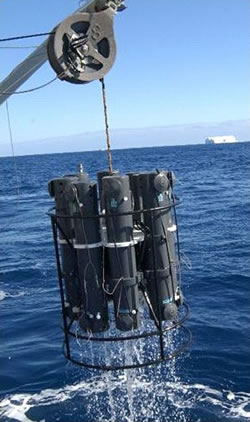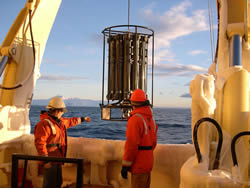Introduction
The first large-scale investigation of trace elements and their isotopes took place during the 1970s, through the Geochemical Ocean Section Study (GEOSECS). The success of this pioneering programme highlighted the benefits of a global specialist consortium. However, since GEOSECS, there have only been isolated studies on individual metals.
Some 30 years on, oceanographer's ability to sample and measure trace metals in water has significantly improved, with clean, contaminant-free sampling procedures and increased sensitivity of analytical instrumentation. With these advancements in metal chemistry there was a growing belief that a new global study of trace elements and their isotopes (TEI) would help the science community understand past, present and future cycles of metals.

In 2003, 85 scientists from 15 countries assembled in France to discuss a new global study to measure and model TEIs; GEOTRACES was born.
So why is it important to understand cycles of metals in the ocean?
The world’s oceans cover approximately 70% of the Earths surface, and yet we know very little about the distribution, cycles and concentration of metals throughout the water column. Metal dynamics are important in helping us understand the complex relationship that exists between the elements and their crucial role in sustaining life within the seas.
The ocean is an important sink of the greenhouse gas carbon dioxide, since an estimated 40% of all photosynthesis on Earth occurs in the worlds vast oceans. This drawdown of carbon dioxide from the surface ocean to deeper waters can strongly influence the partial pressure of carbon dioxide in the Earth’s atmosphere.
Some metals, such as iron, are essential micronutrients to phytoplankton and in many regions of the world’s oceans the concentrations of these metals are so low they limit the biological growth. It is therefore crucial that we can gain further understanding of the dynamics of metals in the world’s oceans today.
With increasing global change due to human activities we also need to establish a baseline level of trace metals, which can be used as a comparison for future generations on assessing increased anthropogenic inputs.
Overview
Three overriding goals support the GEOTRACES mission
-
To determine global ocean distributions of selected trace elements and isotopes, including their concentration, chemical speciation, and physical form, and to evaluate the sources, sinks, and internal cycling of these species and thereby characterise more completely the physical, chemical and biological processes regulating their distribution.
-
To understand the processes involved in ocean trace element cycles sufficiently well that the response of these cycles to global change can be predicted, and their impact on the carbon cycle and climate understood.
-
To understand the processes that control the concentrations of geochemical species used for proxies of the past environment, both in the water column and in the substrates that reflect the water column.
These goals will be pursued through complementary research strategies, including observations, experiments and modelling, organised under the following themes

Theme 1: Fluxes and processes at the ocean interfaces
- Atmospheric deposition
- Continental run-off
- The sediment-water boundary
- Ocean crust
Theme 2: Internal cycling
- Uptake and removal from surface waters
- Uptake and regeneration in the sub-surface ocean
- Regeneration at the sea floor
- Physical circulation
Theme 3: Development for proxies for past change
- Factors controlling 'direct' proxy distribution in the ocean
- Factors influencing the distribution of 'indirect' proxies in the ocean
- Palaeoceanographic tracers based on sediment flux

